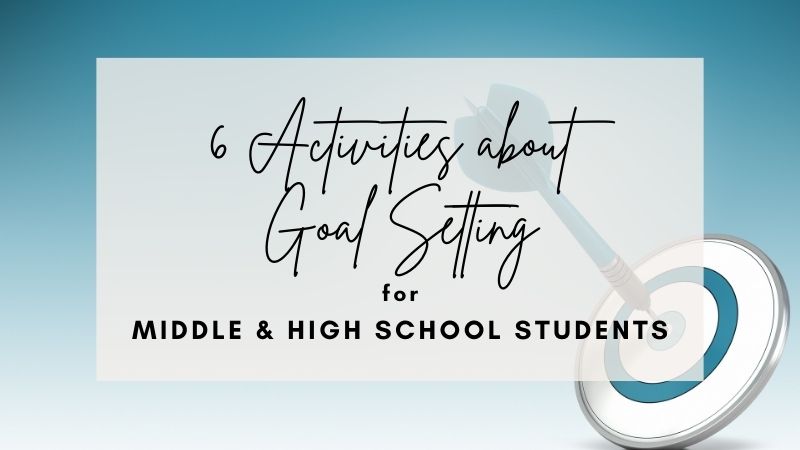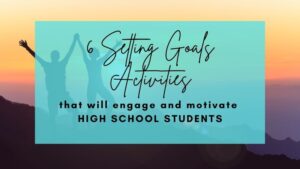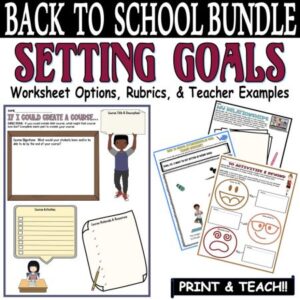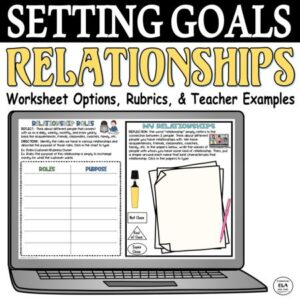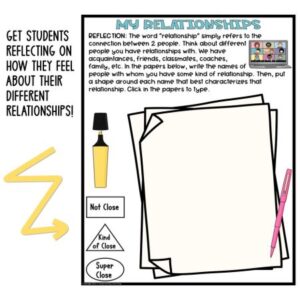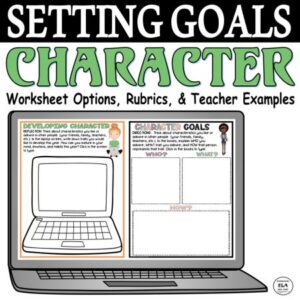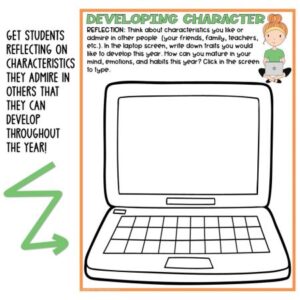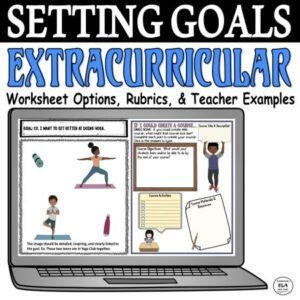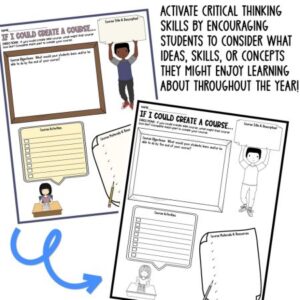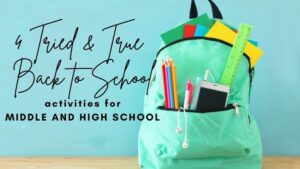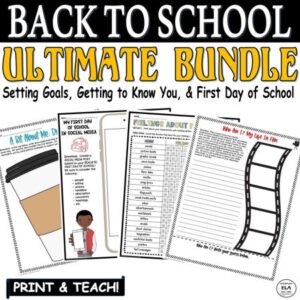Do you know this saying: “A journey of a thousand miles starts with a single step?” Well, the first days back to school are that first single step, and a thousand miles… the rest of the year! So why not get started on the right foot with activities about goal setting for yourself and your students?
As you establish classroom routines, include goal setting for students and for you, too! This post is here to help make that goal easy to achieve. In fact, write the goal NOW that you’re going to include goal setting in the first days of school!
Need help with Test Prep? Check out this FREE Pack of 3 Test Prep Activities to help students achieve success on standardized tests!
Importance of activities about goal setting
A goal is a plan for the future, the desired result for a future time. It means a shift in behavior and focuses on a set period of time. A goal does not need to be immense or intense. It can be simple and straightforward as long as it means a shift from your current reality towards a future desired result.
For example, if you already bring your lunch to school, you won’t make that your goal. Instead, your goal might be to get lunch ready the night before or to plan the week on Sunday.
The thing to note about a goal is that it’s a plan, but if the plan goes awry, you adjust to continue to meet the goal. If one week you forget to plan on Sunday, then you shift and make a plan on Monday or Tuesday. You can then regroup next Sunday.
For students, goal setting is an important lesson. It gives them a sense of purpose when they establish their goals through activities about goal setting, which often increases engagement in class. It develops resilience when they encounter and overcome an obstacle. And most of all, they feel a sense of accomplishment when they achieve a goal, so then they’re ready to make another and another as they continue through school and life!
Activities about Goal Setting: Opportunities to Achieve!
We often focus on goals tied to academic pursuits. Student X says he/she will read eight books that are a mix of fiction and nonfiction. This is a great goal. You could walk students through such reading goals with this set of activities. Or maybe Student Y wants to improve his/her presentation skills by being more vocal in class. Amazing goal! Students can establish education goals with these activities, which include some early writing practice with a paragraph about the goal and their plans to achieve it!
But there are other opportunities for students – and teachers! – to set goals that affect their lives in and beyond the classroom!
Other types of goals you might include:
Relationships with friends, family, and community members-
This type of goal is a flexible option that is relevant to different kinds of personal connections. And let’s be real….relationships of any type are tough to develop and maintain!
Check out these ready-made activities, which walk students through relationship types, roles, and purpose, and then scaffold goal setting.
Movement and Physical Activity-
These types of goals focus on getting your body moving. No one is saying you have to run a marathon or benchpress 200 lbs. Instead, we just want to inspire our students to think about the health of their bodies!
This goal activity is also differentiated with options to reflect through short writing, pictures, and a guided paragraph.
Character/Personal Improvements-
This type targets social and emotional learning (SEL). Too often, we don’t think about developing good character, but we want students to demonstrate positive behaviors!
Use these activities to improve yourself in class or school, or even in your community!
Extracurricular-
This type encourages goals in anything outside of the traditional curriculum such as sports, clubs, hobbies, etc. Education is more than what we teach in the school system. My goal is that students see education as something to develop over their entire lives!
These are timely options for those first days of school.
All of these activities about goal setting give students choices for their own personal development. Keep in mind that you don’t need to do all goals all at once! Start with one or two types by having students work through a goal activity you’ve selected for the whole class. Education goals or reading goals are great options. These activities will help to build relationships with students and get an early diagnostic writing sample too.
A few days later, you can create stations for students to choose one or two other goals. Maybe it’s a goal about movement and physical activity or, as the school teams and clubs get started, a goal about extracurriculars. Then, a bit later, as students are achieving their initial goals, you can build on that momentum and introduce relationship and character goals. This is good timing because you now know your students better, and these types of activities about goal setting may be less risky for them to share with you and their classmates.
Want other ideas for the first days of school? Check out the post below!
Activities About Goal Setting Made Easy
1. Start at the end rather than the beginning:
What are you hoping to change and achieve by using activities about goal setting? Be specific and clear with an end result.
For example, you can make a relationship goal about being a better friend and then add detail about it. You could say that when you spend time with your friends, you’ll listen attentively with your phone away. The ultimate goal is to be a better friend, but the goal demonstrates a clear plan for action! Check out these activities that incorporate visual and written components to help students narrow their focus.
2. Create the process:
Another key factor when incorporating activities about goal setting is the timeline. It is often better to pick a shorter timeline so you can be deliberate with your actions. Plan to achieve a goal in stages so you have a sense of accomplishment that will then push you to the larger end goal. It is not just when will I achieve this goal but what are the steps along the way to achieving it?
If your goal is to read eight books this school year that means you could use eight months to reach your goal. That is a long time between setting and reaching the goal and may lead to procrastination. Instead, break it down to reading one book every month, alternating between fiction and nonfiction. Then, you have eight mini month-to-month goals to reach an ultimate goal. Use this step-by-step goal-setting process for your students’ reading habits (and yours too!).
3. Planning Check-ins:
How will you know you have achieved the goal? Or better yet, how will you know you are on track to achieve the goal? Make sure to include some checkpoints for your own goals and your students too when including activities for goal setting! If there’s a communal timeline – everyone has a goal to complete in 30 days – then you could do short individual check-ins or even have students in groups meet about their progress – a built-in accountability group!
4. Time for Reflection:
This is an important step that should be included along the way too. Reflections can be tied to the check-ins to help everyone stay accountable in these activities about goal setting. It also gives support if there’s an obstacle in the way of success.
These reflections can be quick! Print three emojis – thumbs up, the shoulder shrug, and thumbs down – on a sticky note with a bit of space for writing. Students circle where they are with their goal, and give a sentence with a rationale for the emoji. These exit tickets can prompt a follow-up from you.
As teachers, we know the importance of goal setting. It’s often included in our teacher evaluations or annual learning plans. It’s important that students know that they too can set goals – big and small – and achieve them.
Why do we need to incorporate activities about goal setting?
As they continue through middle school, high school, and beyond, goal setting is a skill that can help them to succeed or to get back up when they fail. Additionally, activities about goal setting don’t just apply to educational settings. Fitness centers ask at sign-up what you want to achieve. Job interviews often ask about where you see yourself in five years. Financial institutions ask about future plans for savings or big purchases, or even, eventually, retirement. These are all questions related to goal setting.
So in the first few days of school help students (and yourself!) with that first single step on a thousand-mile journey by including activities about goal setting in your back to school plan!
CLICK BELOW FOR OTHER ACTIVITIES ABOUT GOAL SETTING AND MORE FOR BACK TO SCHOOL!
Need more fun lessons and activities that involve activities about goal setting? Check out my store Kristin Menke-Integrated ELA Test Prep!

